Automotive Intelligent Cockpit Platform Configuration Strategy and Industry Research Report, 2024
According to the evolution trends and functions, the cockpit platform has gradually evolved into technical paths such as cockpit-only, cockpit integrated with other domains, cockpit-parking integration, cockpit-driving-parking integration, and cockpit-driving integrated central computing platform. OEMs and Tier1s are actively laying out.
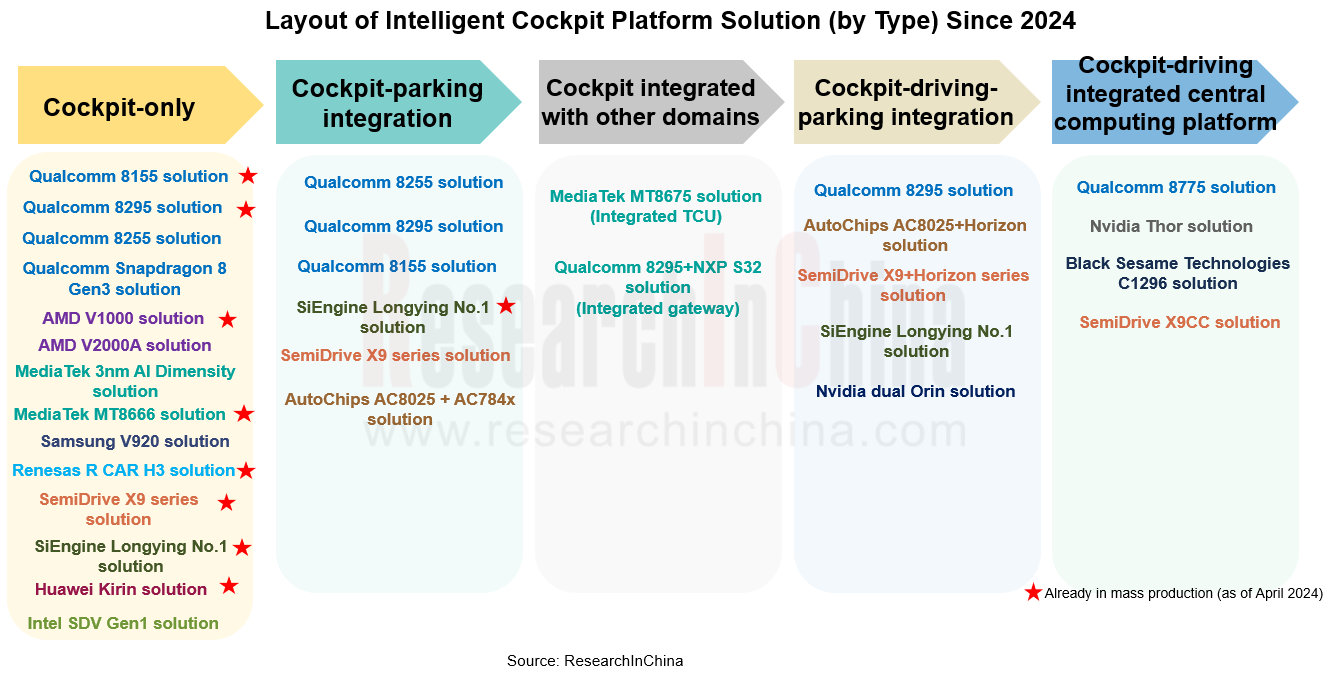
Layout strategy of intelligent cockpit platform solution (by type)
?(1) Cockpit-parking integration: the first choice for mid- to low-configured models, mass production is expected to accelerate in 2024
Cockpit-parking integration fuses parking functions into the cockpit, saving hardware costs for parking controllers. Therefore, OEMs consider it from the perspective of user experience and cost optimization, and mid- to low-configured models are the main market for this solution.
?
In 2024, with the support of high-computing power cockpit SoC products and multi-camera hardware, many mainstream intelligent cockpit solution providers such as Bosch, Visteon, Desay SV, ADAYO, BICV, ECARX, and Yuanfeng Technology have launched relevant cockpit-parking integration solutions.
Most cockpit-parking integration solutions are mainly based on a single cockpit SoC chip to realize intelligent cockpit and parking functions. Qualcomm 8255, Qualcomm 8295, etc. have become the preferred chips for cockpit-parking integration's main single SoC solutions. Products based on this chip platform can enhance system collaboration, improve system performance, and more fully explore and realize cross-domain integration, active intelligence, multimodal interaction, and other functions.
?
(2) Cockpit-driving-parking integration: the optimal solution for cost reduction and efficiency improvement, with L2 ADAS functions integrated in the cabin
?
Cockpit-driving-parking integration integrates the cockpit functional domain with driving and parking functions, while driving domain currently integrates assisted driving functions at L2 and below. Therefore, this solution is mainly suitable for mid- to low-configured models equipped with L2 ADAS functions. High- or top-configured models will still give priority to being equipped with independent driving control units, which have higher requirements for computing power and functional safety levels, and are more difficult to integrate into the cockpit.
?
Leapmotor C10 model, launched in March 2024, is based on the latest "Four Leaf Clover" central integrated EEA. In standard- and mid-configured versions, it uses one SoC chip (Qualcomm 8295/8155) and one MCU chip (NXP S32G), based on QNX Hypervisor to drive multiple systems such as QNX, Android, Linux, and RTOS, achieving deep integration of cockpit and intelligent driving, and realizing L2 intelligent driving (e.g. ACC), instrument cluster, infotainment, sound effects, power amplifier, surround view, fatigue monitoring, whole vehicle, body, gateway, and other functions.
(3) Cockpit-driving integration (central computing platform): Advanced intelligent driving integrated with cockpit, realizing One Box + unified vehicle OS platform, expected to be landed in 2025
?
Cockpit-driving integration is a central computing platform dedicated to achieving One Box, One Board, One Chip (including multi-SoC inter-chip cascading), among which One Chip is widely regarded as the "ultimate solution" for cockpit-driving integration, which runs both intelligent driving domain and intelligent cockpit domain on a single chip.
Currently, multiple suppliers or OEMs have announced the next-generation single-chip cockpit-driving integration layout, but there are slight differences.
Among them, mainstream cockpit Tier1 suppliers such as Bosch, Autolink, ThunderX Auto, Hangsheng Electronics, ADAYO, Zhuoyu Technology, BICV, and Megatronix have announced the creation of cockpit-driving integration solutions based on Qualcomm Snapdragon Ride? Flex 8775. Some suppliers have even implemented a product layout that integrates software and hardware with cockpit-driving integration, aiming at OEMs' demands for cost reduction on intelligence.
ThunderX Auto, a subsidiary of ThunderSoft, created RazorDCX Tarkine, a single-SoC cockpit-driving integration solution based on Qualcomm Snapdragon Ride? Flex SoC. Equipped with ThunderSoft's Aqua Drive OS cockpit-driving integration system, it supports a through-type 8K long screen, displays a full-scenario, immersive, and full 3D interface, and can realize 360° surround view, driver monitoring, game audio & video entertainment, interconnection and other cockpit functions. Meanwhile, it can also support automatic parking, L2++ intelligent driving functions for highways and urban areas, planned to achieve mass production from 2024 to 2025.
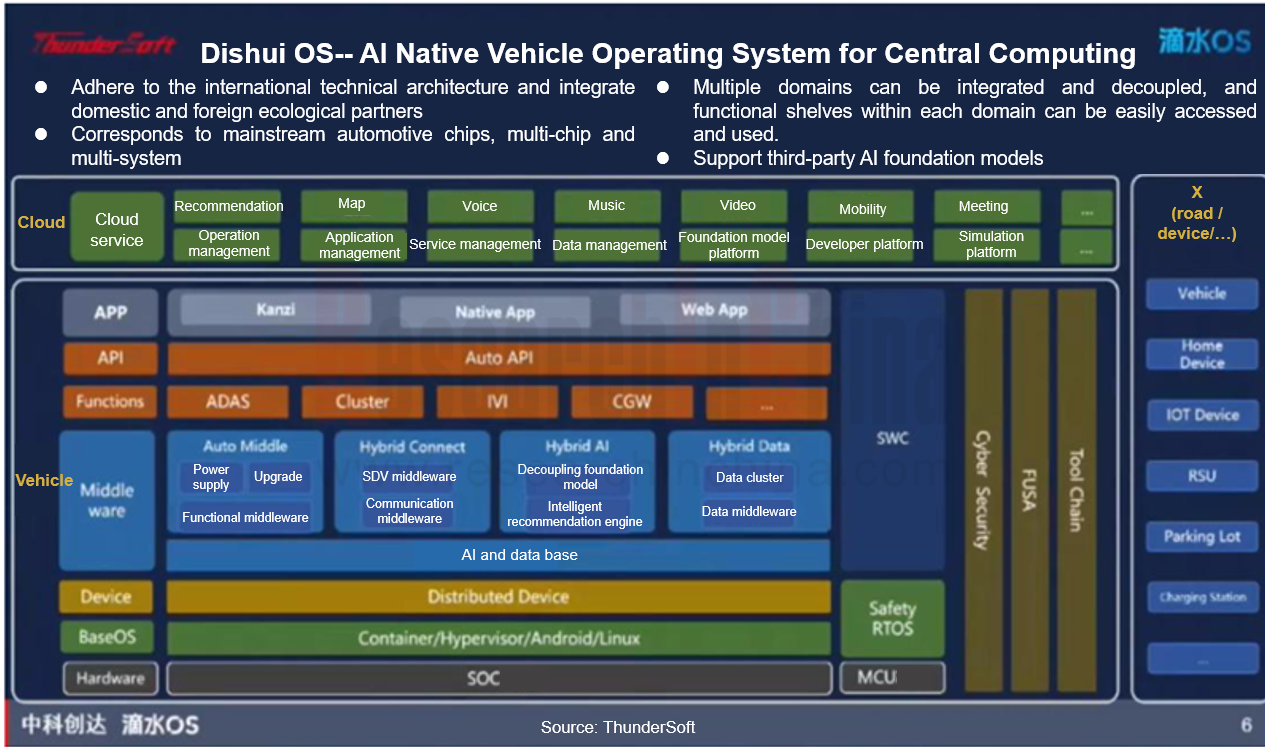
In 2024, companies such as Desay SV, Xpeng Motor, Li Auto, ZEEKR, Jiyue, BYD, and Xiaomi announced that they will create cockpit-driving integration products based on NVIDIA Thor, which can provide "cockpit-driving integration" technical solutions for high-level autonomous driving above L4, and through systematic integration, the software and hardware are fully integrated, shortening the development cycle, significantly reducing costs and improving efficiency.
?
At GTC 2024, Nvidia announced that BYD will adopt Nvidia's next-generation intelligent vehicle chip Thor, which is expected to be used in the central brain of BYD's newly released Xuanji architecture to achieve a cockpit-driving integration layout, while also being compatible with deploying various AI models.
In addition, cockpit-driving integration solutions based on local chips from Black Sesame Technologies and SemiDrive Technology are also being laid out. In April 2024, NESINEXT cooperated with Black Sesame Technologies to release the CoreFusion, a cockpit-driving integration software open platform based on Black Sesame Technologies' automotive cross-domain computing chip Wudang C1296, providing developers with efficient operating system-level software base, development tool chain and complete ecology.
It can be seen that major suppliers and OEMs have accelerated the layout of single-chip cockpit-driving integration solutions, and are expected to achieve mass production as soon as 2025.
?
(4) High-end cockpit AI solution: running AI foundation model in the cabin to achieve 4K/8K HD display and 3D immersive high-performance experiences
?
As generative AI, 4K/8K HD display, 3D immersive experience, multimodal interaction, multi-scenario integration, etc. continue to be introduced into cars, the demand for higher computing power and high-performance cockpit platforms continues to grow, especially in the high-end car market, where market competition is becoming more intense.
?
Beginning in 2023, AI foundation models have become popular. Both emerging and conventional OEMs have introduced them into cockpits. AI foundation models to create future cockpits have become the current mainstream development trend.
?
However, current intelligent cockpit relies more on cloud AI in terms of computing power. Although it can run foundation models with more than 100 billion parameters, the car side currently only has 1 billion parameters or even less, and the performance level is still insufficient.
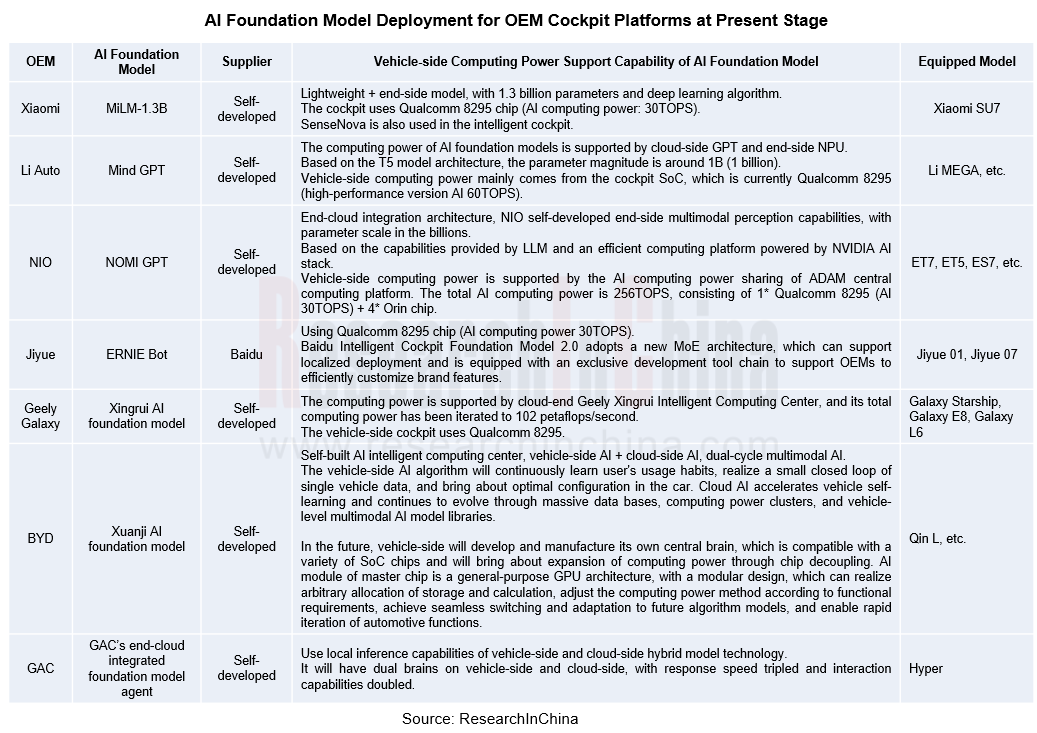
Considering that the cloud-side foundation model is subject to privacy security, latency, stability, cost and other issues, part of calculation and storage during the use of foundation model needs to be completed by vehicle-side computing resources, so the vehicle-side AI foundation model needs to be added. In the future intelligent cockpit, it is necessary to support an AI large language model with more than 7 billion parameters to achieve strong end-side intelligence. In addition, it will also have a full-time online foundation model in-car assistant, full-scenario multimodal interaction and other performance experiences, all of which place higher requirements on intelligent cockpit platform.
In 2024, many OEMs begin to introduce end-side foundation models into their cars. How to match capabilities of end-side foundation models will become one of the key development directions of new intelligent cockpit platforms in the future. Suppliers such as BICV, ECARX, and Shanghai Ruicheng have launched cockpit solution products with high AI performance.
?
In April 2024, BICV announced the creation of MARS06 cockpit solution product based on MediaTek 3nm chip MT8678, which can support end-side running of a 13 billion parameter AI large language model. It is outstanding in performance, multimedia, security technology facilities, audio and video processing capabilities, end-side AI foundation model, etc. And can meet the needs of intelligent vehicles for infotainment and intelligent driving assistance systems, and bring safer, more comfortable and smarter mobility experiences to occupants.
?
And CT-Y1 chip cockpit solution product based on MediaTek's 4nm sub-flagship chip supports a 7 billion parameter foundation model and can generate AI images within 1s. It also supports up to 12 cameras, up to 32MP, as well as multi-screen display and built-in 5G.
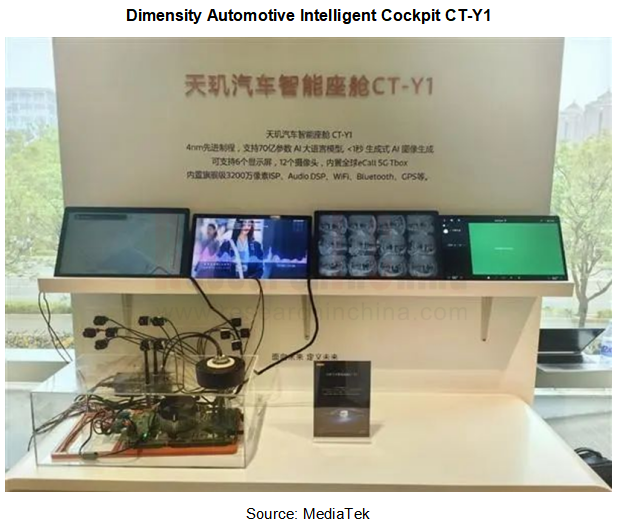
In March 2024, ECARX has released Qogir intelligent cockpit computing platform product, which uses flagship 4nm mobile phone chip Qualcomm Snapdragon 8 Gen3 and is equipped with Flyme Auto + WiFi 7 system. Its hybrid end-side AI reaches 60 TOPS, supports up to 10 billion parameter foundation model platform operation, supports up to 8K display, and hardware supports light tracing technology, providing the ultimate phone-car connectivity experience.
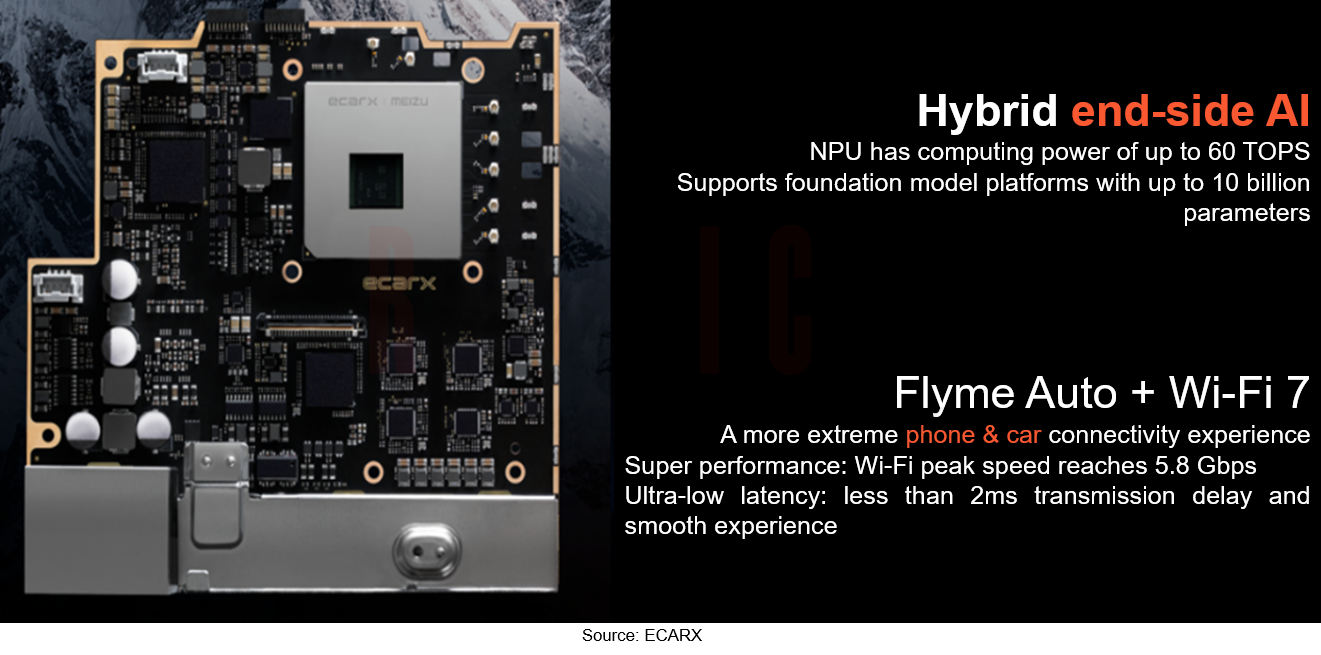
In addition, in 2024, high-performance cockpit platform products based on Qualcomm 8295 from Neusoft Group, Aptiv, Desay SV, Harman and other suppliers have been installed and achieved mass production on models from OEMs such as Jiyue, Geely Galaxy, ZEEKR, Li Auto, Xiaomi, Mercedes-Benz, etc. Its AI computing power reaches 30TOPS (the high-performance version reaches 60TOPS) and adopts a dual NPU architecture, which can effectively improve the speed and performance of foundation model calculations and help the efficient operation of end-side AI foundation models.
Furthermore, products based on cockpit-only platform solutions such as Samsung V920, Intel and Qualcomm consumer chips will also be mass-produced from 2024 to 2025, making market competition more intense.
Mainstream next-generation cockpit platform supplier layout: high computing power, focus on AI, flexible and customizable
Qualcomm 8255 cockpit platform solution: booming in 2024, may be the next-generation mainstream automotive solution
From the perspective of supplier layout, Qualcomm remains the main product in the market, mainly Qualcomm 8295 and Qualcomm 8255. Especially the Qualcomm 8255 product, highly recommended by Qualcomm, many OEMs who used to make 8295 intelligent cockpits have begun to access to 8255. However, performance of SA8255 is lower than that of SA8295, especially in terms of GPU performance. CPU performance is also slightly lower than SA8295. But in AI, SA8255 can reach up to 48TOPS, and the price is significantly lower than SA8295.
Beginning in 2024, many mainstream Tier 1 companies have launched their cockpit platform products based on Qualcomm 8255 chip, positioned as an upgraded version of Qualcomm 8155, which can directly undertake Qualcomm 8155 cockpit system ecology and shorten the development cycle for vehicle installations. At the same time, based on high computing power of 8255, cockpit integration solutions such as cockpit-parking integration can also be realized. It is expected that in 2024-2025, Qualcomm 8255 cockpit platform products are expected to inherit the Qualcomm 8155 market and become the mainstream solution in the market.
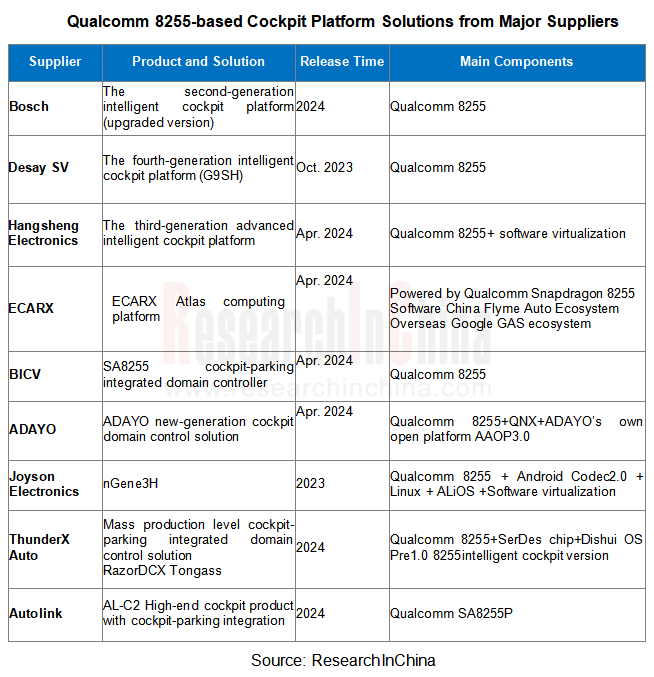
Samsung V920 platform solution: mainly deployed by Harman, Visteon and other foreign Tier1s, and Hyundai is the first to mass-produce and install it
In 2024, Harman launched the latest Ready Upgrade Advanced cockpit domain controller, which provides optimized solutions for high-end models or OEMs who want to add more displays, richer safety functions, and connectivity services to existing vehicles. Provide superior in-car experience through? new Samsung Exynos processor, and introduce new features and service capabilities for on-demand access through Harman Ignite Store app and third-party applications. Meanwhile, Harman also collaborates with TE Connectivity to achieve easier hardware upgradability via patented NET-AX + modular hybrid connectors.
AMD V2000A platform solution: creating the ultimate cockpit for PC-level performance
ECARX builds Makalu computing platform, based on AMD Ryzen embedded V2000 processor and Radeon RX6600 series GPU. Equipped with ECARX Cloudpeak cross-domain system, it can provide console game-level graphics and image rendering capabilities. It also supports the latest graphics processing interface of PC-level computing platform and Unreal Engine 5, which can realize real-time rendering of 3D environment and 7.X.4 panoramic spatial audio. Comprehensively empower partners to create full-scenario 3D immersive cockpit functions and provide a complete soft and hard capability base for the next-generation intelligent cockpit products. It will be mass-produced in Smart models in 2024.
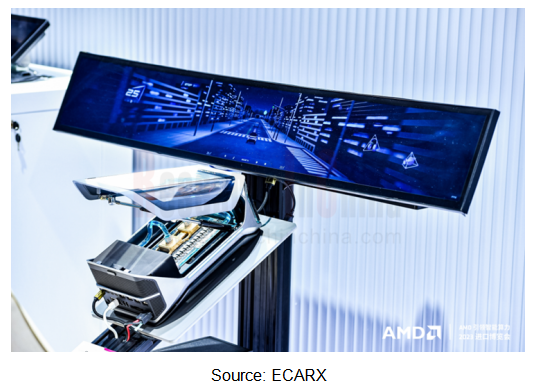
1 Analysis of Intelligent Cockpit Platform Configuration Strategy and Development Direction
Summary (1)
Summary (2)
1.1 Summary of Automotive Intelligent Cockpit Platform Development Trends
1.1.1 Definition of Automotive Intelligent Cockpit Platform
1.1.2 Current Cockpit Platform Hardware is Dominated by SoC External with MCU Architecture
1.1.3 Composition of Intelligent Cockpit Software Platform
1.1.4 Evolution of Intelligent Cockpit Software Platform
1.1.5 Evolution Routes of Intelligent Cockpit Platform
1.1.6 Forecast of Time to Implement Various Cockpit Platforms
1.2 Cockpit Platforms and Architectures for Mainstream Layouts in 2024
1.2.1 Classification of Mainstream Cockpit Platform Solutions
1.2.2 Mainstream Cockpit Platform Solutions in 2024
1.2.3 Market Share of Mainstream Cockpit Platform Solutions in Mass Production
1.2.4 Cockpit Platform Architecture (1)
1.2.5 Cockpit Platform Architecture (1)
1.2.6 Cockpit Platform Architecture (2)
1.2.7 Cockpit Platform Architecture (3)
1.2.8 Cockpit Platform Architecture (3)
1.2.9 Cockpit Platform Architecture (4)
1.2.10 Cockpit Platform Architecture (5)
1.2.11 Cockpit Platform Architecture (6)
1.2.12 Cockpit Platform Architecture (7)
1.2.13 Cockpit Platform Architecture (8)
1.3 Development Direction of Intelligent Cockpit Platform (1): Cockpit-only Platform
1.3.1 Demand Drivers for Cockpit-only Platform Solution
1.3.2 Latest Cockpit-only Platform Solution in 2024 (1)
1.3.3 Latest Cockpit-only Platform Solution in 2024 (2)
1.3.4 Cockpit-only Platform Product (1)
1.3.5 Cockpit-only Platform Product (2)
1.3.6 Cockpit-only Platform Product (3)
1.3.7 Cockpit-only Platform Product (4):
1.4 Development Direction of Intelligent Cockpit Platform (2): Layout and Trends of Cockpit-parking Integration Solution
1.4.1 Status Quo and Trends of Cockpit-parking Integration Solution
1.4.2 Major Cockpit-parking Integration Solution (1)
1.4.3 Major Cockpit-parking Integration Solution (2)
1.4.4 Major Cockpit-parking Integration Solution (3)
1.4.5 Architecture of Cockpit-parking Integration Solution (1)
1.4.6 Architecture of Cockpit-parking Integration Solution (2)
1.4.7 Architecture of Cockpit-parking Integration Solution (3)
1.4.8 Architecture of Cockpit-parking Integration Solution (4)
1.5 Development Direction of Intelligent Cockpit Platform (3): Layout and Trends of Low- and Mid-level Cockpit-driving-parking Integration Solution
1.5.1 Layout Modes and Positioning of Cockpit-driving-parking Integration
1.5.2 Major Cockpit-driving-parking Integration Solutions
1.5.3 Cases of Released Model with Cockpit-driving-parking Integration
1.5.4 Architecture of Cockpit-driving-parking Integration Solution (1)
1.5.5 Architecture of Cockpit-driving-parking Integration Solution (2)
1.5.6 Architecture of Cockpit-driving-parking Integration Solution (3)
1.5.7 Architecture of Cockpit-driving-parking Integration Solution (4)
1.5.8 Major Case (1)
1.5.9 Major Case (2)
1.5.10 Major Case (3)
1.6 Development Direction of Intelligent Cockpit Platform (4): Solutions of Cockpit Integrated with Connectivity and other Functional Domains
1.6.1 Layout of Cockpit Integrated with Connectivity Domain
1.6.2 Product Solution Architecture
1.6.3 Product Case (1)
1.6.4 Product Case (2)
1.7 Development Direction of Intelligent Cockpit Platform (5): Cockpit-driving integrated Central Computing Platform
1.7.1 Major Layout Method of Cockpit-driving Integration
1.7.2 Vehicle Central Computing Platform Architecture Solution 1
1.7.3 Vehicle Central Computing Platform Architecture Solution 2
1.7.4 Intelligent Cockpit Development Form under the Trend of Cockpit-driving Integration
1.7.5 Evolution of Intelligent Cockpit Development under the Trend of Cross-domain Integration
1.7.6 Cockpit-driving Integration Solution of Major Companies (1)
1.7.7 Cockpit-driving Integration Solution of Major Companies (2)
1.7.8 Optional SOC for Single-chip Cockpit-driving Integration Solution
1.7.9 Single-chip Cockpit-driving Integration Configuration Solution (1)
1.7.10 Single-chip Cockpit-driving Integration Configuration Architecture (1)
1.7.11 Single-chip Cockpit-driving Integration Configuration Architecture (2)
1.7.12 Single-chip Cockpit-driving Integration Configuration Solution (2)
1.7.13 Single-chip Cockpit-driving Integration Configuration Solution (3)
1.7.14 Single-chip Cockpit-driving Integration Configuration Solution (4)
1.7.15 Single-chip Central Computing Platform Configuration Solution (4)
1.7.16 Single-chip Central Computing Platform Configuration Solution (4)
1.7.17 Case: Baidu's Automotive Cockpit-driving Integrated and Software-chip Fusion Intelligent Computing Platform
1.7.18 Cockpit-driving Integration Software Architecture: Vehicle OS Requirement Enhancement
1.7.19 Vehicle OS Layout Planning of Cockpit-driving Integrated Software in Major OEMs
1.8 Intelligent Cockpit Platform (by Type) Market Size and Penetration Rate Trends
1.8.1 Installations and Penetration Rate of Intelligent Cockpit Platforms in China, 2023-2027
1.8.2 Market Size of Cockpit Platforms (by Type) in China, 2023-2027
1.8.3 Market Penetration Rate of Intelligent Cockpit Platforms (by Type) in China, 2023-2027
1.8.4 Market Share of Intelligent Cockpit Platform Suppliers in China Intelligent Passenger Cars, 2023
2 Intelligent Cockpit Platform Suppliers' Solutions and Competitiveness
Summary (1)
Summary (2)
Summary (3)
Summary (4)
2.1 Development Layout and Competitiveness of Intelligent Cockpit Platforms from Major Chinese Suppliers
2.1.1 Evolution of Cockpit Platform Solutions from Major Chinese Suppliers (1)
2.1.2 Evolution of Cockpit Platform Solutions from Major Chinese Suppliers (2)
2.1.3 Evolution of Cockpit Platform Solutions from Major Chinese Suppliers (1)
2.1.4 Evolution of Cockpit Platform Solutions from Major Chinese Suppliers (2)
2.1.5 Evolution of Cockpit Platform Solutions from Major Chinese Suppliers (3)
2.1.6 Competitiveness of Major Chinese Cockpit Platform Suppliers (1)
2.1.7 Competitiveness of Major Chinese Cockpit Platform Suppliers (2)
2.1.8 Competitiveness of Major Chinese Cockpit Platform Suppliers (3)
2.2 Development Layout and Competitiveness of Intelligent Cockpit Platforms from Major Foreign Suppliers
2.2.1 Evolution of Cockpit Platform Solutions from Major Foreign Suppliers (1)
2.2.2 Evolution of Cockpit Platform Solutions from Major Foreign Suppliers (2)
2.2.3 Competitiveness of Major Foreign Cockpit Platform Suppliers
2.2.4 Competitiveness of Major Foreign Cockpit Platform Suppliers
2.3 Latest Solutions and Main Functions of Intelligent Cockpit Platform Solutions (by Platform Category) from Major Suppliers
2.3.1 Qualcomm 8295 Cockpit Platform (1)
2.3.2 Qualcomm 8295 Cockpit Platform (2)
2.3.3 Qualcomm 8255 Cockpit Platform (1)
2.3.4 Qualcomm 8255 Cockpit Platform (2)
2.3.5 Qualcomm 8775 Cockpit-driving Integration Platform
2.3.6 Qualcomm Consumer Chip Cockpit Platform
2.3.7 MediaTek Cockpit Platform
2.3.8 Samsung Exynos Auto Cockpit Platform
2.3.9 AMD Cockpit Platform
2.3.10 SemiDrive X9 Series Cockpit Platform
2.3.11 SiEngine Longying No. 1 Cockpit Platform
2.3.12 Autochips AC8025 Cockpit Platform
2.4 Intelligent Cockpit Platform Development and Supply Modes Evolution
2.4.1 Evolution Trend of Intelligent Cockpit System Development
2.4.2 Four Supply Modes of Intelligent Cockpit Platforms
2.4.3 Shift in Cockpit Supply Modes of Major Suppliers (1)
2.4.4 Shift in Cockpit Supply Modes of Major Suppliers (2)
2.4.5 OEMs' Cockpit Supply Demands
2.4.6 Major Suppliers' Cockpit Platform Development Cycles Continuously Shortening
2.4.7 Exploring New Development Patterns (1)
2.4.8 Exploring New Development Patterns (2)
2.4.9 Exploring New Development Patterns (3)
2.4.10 Exploring New Development Patterns (4)
2.5 Layout of Cockpit Platforms Going Overseas
2.5.1 Overseas Demand for Intelligent Cockpits
2.5.2 Main Challenging Factors for Overseas Layout of Intelligent Cockpit Platforms
2.5.3 Overseas Layout Path of Intelligent Cockpit Platforms
2.5.4 Chinese OEMs Actively Lay Out Overseas Business to Promote China's Intelligent Cockpit Platforms Overseas
2.5.5 Overseas Intelligent Cockpit Platform Solutions of Major Suppliers
2.5.6 Overseas Cockpit Platform Product Solution (1)
2.5.7 Overseas Cockpit Platform Product Solution (2)
2.5.8 Overseas Cockpit Platform Product Solution (3)
2.5.9 Overseas Cockpit Platform Product Solution (4)
2.5.10 Overseas Cockpit Platform Product Solution (5)
2.5.11 Overseas Cockpit Platform Product Solution (6)
2.5.12 Overseas Cockpit Platform Product Solution (7)
2.5.13 Overseas Cockpit Platform Product Solution (8)
2.5.14 Overseas Cockpit Platform Product Solution (9)
2.5.15 Overseas Cockpit Platform Product Solution (10)
2.6 Localization for Intelligent Cockpit Platforms
2.6.1 Status Quo of Intelligent Cockpit Platform Localization
2.6.2 Bottlenecks of Intelligent Cockpit Platform Localization
2.6.3 Demand for Localization of Intelligent Cockpit Platforms
2.6.4 Main Advantages of Intelligent Cockpit Platform Localization
2.6.5 Types of Localized Solutions for Intelligent Cockpit Platforms
2.6.6 Current Intelligent Cockpit Platform Localized Solutions
2.6.7 Layout of Localized Cockpit Platform Solutions of Some Cockpit Suppliers
2.6.8 Case (1)
2.6.9 Case (2)
2.6.10 Case (3)
2.6.11 Case (4)
3 Intelligent Cockpit Platform Supporting Relationships and Development Trends of OEMs
Summary (1)
Summary (2)
Summary (3)
Summary (4)
3.1 Intelligent Cockpit Platform Supporting Relationships of Major OEMs
3.1.1 Intelligent Cockpit Platform Supply Relationships for Emerging OEM Brands
3.1.2 Intelligent Cockpit Platform Supply Relationships for Chinese Independent OEM Brands (1)
3.1.3 Intelligent Cockpit Platform Supply Relationships for Chinese Independent OEM Brands (2)
3.1.4 Intelligent Cockpit Platform Supply Relationships for Chinese Independent OEM Brands (3)
3.1.5 Intelligent Cockpit Platform Supply Relationships for Chinese Independent OEM Brands (4)
3.1.6 Intelligent Cockpit Platform Supply Relationships for Chinese Independent OEM Brands (5)
3.1.7 Intelligent Cockpit Platform Supply Relationships for Joint Venture OEM Brands (1)
3.1.8 Intelligent Cockpit Platform Supply Relationships for Joint Venture OEM Brands (2)
3.2 OEMs' Cockpit Platform Layout Planning
3.2.1 Summary of OEMs’ Intelligent Cockpit Layout Characteristics (1)
3.2.2 Summary of OEMs’ Intelligent Cockpit Layout Characteristics (2)
3.2.3 Summary of OEMs’ Intelligent Cockpit Layout Characteristics (3)
3.2.4 Summary of OEMs’ Intelligent Cockpit Layout Characteristics (4)
3.2.5 OEMs' Software-level Layout
3.2.6 OEMs' Cockpit Layout Characteristics
3.2.7 Future Cockpit Layout of Emerging OEMs (1)
3.2.8 Future Cockpit Layout of Emerging OEMs (2)
3.2.9 Future Cockpit Layout of Chinese Independent OEMs (1)
3.2.10 Future Cockpit Layout of Chinese Independent OEMs (2)
3.2.11 Future Cockpit Layout of Foreign OEMs (1)
3.2.12 Future Cockpit Layout of Foreign OEMs (2)
3.3 New Trend in OEMs’ Intelligent Cockpit Platform Development (1): AI Foundation Model Applied in Cockpit
3.3.1 Vehicle AI Foundation Model Builds New Future Cockpits: Main Development Direction for End-Side, End-Cloud Integrated Foundation Model
3.3.2 Vehicle AI Foundation Model Empowers New Paradigm of Human-Vehicle Interaction
3.3.3 Vehicle AI Foundation Model Generates High Computing Power and Strong Performance Cockpit-only Platform Solution Layout
3.3.4 Vehicle AI Foundation Model Generates High-Computing Power Cockpit-only Platform Solution Layout
3.3.5 Impact of AI Foundation Model on Intelligent Cockpit
3.3.6 Main Application Types of AI Foundation Model Intelligent Cockpit
3.3.7 Deployment of AI Foundation Model
3.3.8 Advantages of AI Foundation Model End-side Deployment
3.3.9 Vehicle AI Foundation Model’s Requirements for Intelligent Cockpit Underlying Computing Power
3.3.10 Vehicle AI Foundation Model’s Requirements for Intelligent Cockpit Underlying Computing Power
3.3.11 Layout of Computing Power Support for Introducing AI Foundation Model into Intelligent Cockpit of Major OEMs
3.3.12 Layout of Computing Power Support for Introducing AI Foundation Model into Intelligent Cockpit of Major OEMs
3.3.13 Case of AI Foundation Model Cockpit Underlying Hardware Platform Deployment of OEMs (1)
3.3.14 Case of AI Foundation Model Cockpit Underlying Hardware Platform Deployment of OEMs (2)
3.3.15 Case of AI Foundation Model Cockpit Underlying Hardware Platform Deployment of OEMs (3)
3.3.16 Case of AI Foundation Model Cockpit Underlying Hardware Platform Deployment of OEMs (4)
3.3.17 Degree of AI Model Computing Power Support for Latest Intelligent Cockpit SoC Products
3.3.18 AI Computing Power of Major Cockpit SoCs
3.3.19 Main End-side AI Foundation Model Intelligent Cockpit Platform Solution (1)
3.3.20 Main End-side AI Foundation Model Intelligent Cockpit Platform Solution (2)
3.3.21 Main End-side AI Foundation Model Intelligent Cockpit Platform Solution (3)
3.3.22 Main End-side AI Foundation Model Intelligent Cockpit Platform Solution (4)
3.3.23 Main End-side AI Foundation Model Intelligent Cockpit Platform Solution (5)
3.4 New Trend in OEMs’ Intelligent Cockpit Platform Development (2): Phone-car Connection
3.4.1 Evolution History of Phone-car Connection Layout
3.4.2 Phone-car Connection Demands for Intelligent Cockpit Platform (1)
3.4.3 Phone-car Connection Demands for Intelligent Cockpit Platform (2)
3.4.4 Development Trends of Phone-car Connection (1)
3.4.5 Development Trends of Phone-car Connection (2)
3.4.6 Phone-car Connection Layout Solutions of Major Suppliers
3.4.7 Solutions of Phone-car Connection Cockpit Platform Layout (1)
3.4.8 Solutions of Phone-car Connection Cockpit Platform Layout (2)
3.4.9 Solutions of Phone-car Connection Cockpit Platform Layout (3)
3.4.10 Solutions of Phone-car Connection Cockpit Platform Layout (4)
3.4.11 Solutions of Phone-car Connection Cockpit Platform Layout (5)
3.4.12 Solutions of Phone-car Connection Cockpit Platform Layout (6)
3.4.13 Solutions of Phone-car Connection Cockpit Platform Layout (7)
3.4.14 Solutions of Phone-car Connection Cockpit Platform Layout (8)
3.4.15 Solutions of Phone-car Connection Cockpit Platform Layout (9)
3.4.16 Solutions of Phone-car Connection Cockpit Platform Layout (10)
4 Intelligent Cockpit Platform Layout of OEMs
4.1 Tesla
4.1.1 Evolution of Intelligent Cockpit Platforms
4.1.2 R&D Timeline of Intelligent Cockpit
4.1.3 Suppliers of Intelligent Cockpit Software System
4.1.4 Evolution of MCU (1)
4.1.5 Evolution of MCU (2)
4.1.6 HW4.0 Cockpit Domain
4.1.7 Cockpit Software Platform
4.2 Mercedes-Benz
4.2.1 Intelligent Cockpit R&D Department
4.2.2 China's Local Intelligent Cockpit Development Modes
4.2.3 Suppliers of Intelligent Cockpit Software System
4.2.4 R&D Timeline of Intelligent Cockpit
4.2.5 Evolution Trend of Cockpit Hardware and Software Platforms
4.2.6 CIVIC Cockpit Hardware (1)
4.2.7 CIVIC Cockpit Hardware (2)
4.2.8 MB.OS
4.2.9 Description of MB.OS
4.2.10 System Hardware Layer of MB.OS
4.2.11 System Software Layer of MB.OS
4.3 BMW
4.3.1 Layout of Cockpit Software Field
4.3.2 Localization Strategy in China
4.3.3 Cockpit Localization Strategy in China (1)
4.3.4 Cockpit Localization Strategy in China (2)
4.3.5 Evolution and Suppliers of Intelligent Cockpit Platforms (1)
4.3.6 Evolution and Suppliers of Intelligent Cockpit Platforms (2)
4.3.7 Latest-generation Cockpit Domain: IDC23 (1)
4.3.8 Latest-generation Cockpit Domain: IDC23 (2)
4.3.9 IDC23 VS MGU22
4.3.10 Latest Cockpit Software System
4.3.11 First Android-based Cockpit System ID9.0
4.3.12 Evolution of Intelligent Cockpit Human-Computer Interaction
4.3.13 Next-generation Cockpit Software System
4.4 Volkswagen
4.4.1 Intelligent Cockpit Layout
4.4.2 Evolution of Intelligent Cockpit
4.4.3 Self-developed Operating System - VW.OS
4.4.4 Software Platform Planning and Layout
4.4.5 ICAS3 Cockpit Domain Controller System
4.4.6 Software Platform System Planning for Chinese Team
4.4.7 “In China, For China” Development Strategy
4.4.8 Intelligent Cockpit Software R&D Layout of Volkswagen (China)
4.5 Audi
4.5.1 Intelligent Cockpit Layout
4.5.2 Hardware and Software Layout (1)
4.5.3 Hardware and Software Layout (2)
4.5.4 Hardware and Software Layout (3)
4.5.5 Evolution of Cockpit Software System
4.6 Volvo
4.6.1 Cockpit Layout
4.6.2 Cockpit of EX90 SUV BEV
4.6.3 Cockpit of XC90 BEV
4.6.4 Cooperation with Qualcomm to Deploy Intelligent Cockpits
4.6.5 VolvoCars.OS
4.6.6 Localized Team Building for Volvo China
4.7 Ford
4.7.1 Cockpit System Evolution
4.7.2 New-generation Automotive Cockpit Domain Controllers
4.7.3 New-generation In-vehicle Infotainment System
4.7.4 SYNC 4.0
4.7.5 China SYNC+
4.7.6 Intelligent Cockpit Planning and Development in China
4.8 Stellantis
4.8.1 Profile
4.8.2 Development Plan
4.8.3 Layout of Three Technology Platforms (1)
4.8.4 Layout of Three Technology Platforms (2)
4.8.5 Intelligent Cockpit Platform Layout
4.8.6 Intelligent Cockpit AI Deployment in 2024
4.9 BYD
4.9.1 New DiLink Cockpit Platform
4.9.2 New DiLink Cockpit Platform and Hardware Planning
4.9.3 New DiLink Cockpit Platform Software and Hardware Development Evolution
4.9.4 Cockpit Software Architecture: Full-stack Self-developed Technology
4.9.5 Sub-branded Intelligent Cockpit
4.9.6 Intelligent Cockpit of Dynasty Series
4.9.7 Intelligent Cockpit of Ocean Series
4.9.8 Intelligent Cockpit of Yangwang Brand
4.9.9 Intelligent Cockpit of Denza Brand: Denza Link Ultra Intelligent Interactive Cockpit
4.9.10 Intelligent Cockpit of Fangchengbao
4.9.11 Overseas Models of Han and Tang Will Pack 8155-based Cockpit Solutions
4.9.12 Layout of Cockpit-driving Integration
4.9.13 Xuanji Architecture
4.10 Great Wall Motor
4.10.1 Intelligent Cockpit Layout
4.10.2 Intelligent Industry Chain Layout
4.10.3 Iteration Route of Intelligent Cockpit Platform
4.10.4 Next-generation Intelligent Cockpit System
4.10.5 Self-developed Cockpit Operating System - GC-OS
4.10.6 Coffee Intelligent Cockpit 2.0
4.10.7 Cockpit-driving Integration Planning
4.10.8 Central Computing SOA
4.11 SAIC
4.11.1 Intelligent Cockpit Layout
4.11.2 Several Solutions for Intelligent Cockpit
4.11.3 Evolution of Intelligent Cockpit Software Systems for Passenger Cars
4.11.4 Next-generation New Software System
4.11.5 Latest-generation Galaxy Intelligent Cockpit Solution of SAIC Z-ONE
4.11.6 SAIC Z-ONE’s First-generation Central Brain: ZXD1
4.11.7 SAIC Z-ONE’s First-generation Central Brain: ZXD2
4.11.8 SAIC Z-ONE’s Intelligent Cockpit Computing Platform - ZCM
4.11.9 Z-ONE Galaxy Cockpit-driving Integrated Computing Platform -ZXD
4.11.10 Full-stack Software and Hardware Solutions of Z-ONE Galaxy Cockpit-driving Integration
4.11.11 R&D Timeline of Intelligent Cockpit for IM Motors
4.11.12 First-generation Cockpit Domain Controller of IM Motors
4.11.13 Latest Cockpit OS of IM Motors
4.11.14 IM Motors Releases Full-course AI Cockpit
4.11.15 Suppliers of Intelligent Cockpit Software System for IM Motors
4.12 GAC
4.12.1 Intelligent Cockpit Layout
4.12.2 Development History of Intelligent Cockpit Ecosystem
4.12.3 Latest Intelligent Cockpit Products
4.12.4 Intelligent Cockpit Development Planning
4.12.5 Psi OS
4.12.6 Cooperation between GAC Trumpchi and Huawei
4.13 Geely
4.13.1 Intelligent Cockpit
4.13.2 Intelligent Cockpit System Solutions by Brand (1)
4.13.3 Intelligent Cockpit System Solutions by Brand (2)
4.13.4 Lynk&Co Intelligent Cockpit System Solution and Evolution
4.13.5 Cockpit Chip Layout Planning
4.13.6 Vehicle OS
4.13.7 Cockpit OS
4.13.8 Intelligent Cockpit OS Planning
4.13.9 Cockpit Software and Hardware Platform Evolution Trends of ZEEKR
4.13.10 R&D Timeline of Intelligent Cockpit for ZEEKR
4.13.11 Suppliers of Intelligent Cockpit Software System for ZEEKR
4.13.12 Intelligent Cockpit Development Direction for ZEEKR
4.14 FAW Hongqi
4.14.1 Evolution of Intelligent Cockpit System
4.14.2 Evolution of Intelligent Cockpit Platform (1)
4.14.3 Evolution of Intelligent Cockpit Platform (2)
4.14.4 FAW Group Cooperates with ECARX to Create Intelligent Cockpit
4.14.5 Layout of Cockpit-driving Integration
4.14.6 China FAW Releases “Hongqi - Jiuzhang” Intelligent Platform HIS
4.15 BAIC
4.15.1 Intelligent Cockpit Layout
4.15.2 Latest Intelligent Cockpit: Lingzhi OS Cockpit System
4.15.3 Latest High Computing Power Intelligent Cockpit Domain Control Platform
4.15.4 Cooperation with Huawei Intelligent Cockpit
4.16 Changan Automobile
4.16.1 Intelligent Cockpit Layout
4.16.2 Intelligent Cockpit Layout Route of Nevo
4.16.3 Intelligent Cockpit Layout Route of Deepal
4.16.4 Intelligent Cockpit Route of Avatr
4.16.5 Intelligent Cockpit Layout of oShan
4.16.6 New Dynamics of Cooperation with Huawei
4.16.7 Super Digital Integration Platform SDA for Full Scenario Services
4.16.8 Cockpit-driving Integration Layout: “UNIBrain Central Computing Platform”
4.17 Neta Auto
4.17.1 Intelligent Cockpit Systems for Major Models
4.17.2 Evolution of Intelligent Cockpit System
4.17.3 Shanhai Platform 2.0 Intelligent Cockpit
4.17.4 Collaboration with Autolink to Lay Out the Latest Cockpit Domain Controller and Cockpit-driving Integrated Domain Controller
4.17.5 Released the Self-developed 3-in-1 Cockpit Domain Controller Platform with MediaTek
4.17.6 Haozhi Intelligent Vehicle Central Supercomputing Platform: 2.0 to Realize Cockpit-driving Integration
4.17.7 Intelligent Cockpit System Suppliers
4.18 Li Auto
4.18.1 Cockpit Configuration
4.18.2 Evolution of Intelligent Cockpit
4.18.3 Cockpit-driving Integration Planning
4.18.4 Next-generation Cockpit Software System
4.18.5 Li AI Intelligent Cockpit Space System
4.18.6 Intelligent Cockpit Supplier Series
4.19 Xpeng Motor
4.19.1 Intelligent Cockpit Systems in Major Models
4.19.2 Evolution of Cockpit Intelligent System
4.19.3 Cockpit Intelligent System Development Strategy
4.19.4 Cockpit Intelligent System Teams
4.19.5 Cockpit Intelligent System Hardware and Software Supply Chain Deployment
4.19.6 Latest Intelligent Cockpit System Architecture
4.19.7 Latest Intelligent Cockpit System Functions
4.19.8 Layout of Cockpit-driving Integration
4.20 Xiaomi Auto
4.20.1 Intelligent Cockpit System
4.20.2 Intelligent Cockpit Domain Control Platform
4.20.3 Software System: HyperOS
4.20.4 Main Highlights of Cockpit Software System (1)
4.20.5 Main Highlights of Cockpit Software System (2)
4.20.6 Major Suppliers of Intelligent Cockpit
4.21 NIO
4.21.1 Cockpit Systems for Major Models
4.21.2 Cockpit System Evolution (1): Toward Self-Research
4.21.3 Cockpit System Evolution (2): Software System to Vehicle OS
4.21.4 Next-generation Intelligent Cockpit Systems
4.21.5 Central Computing Platform ADAM
4.22 Leapmotor
4.22.1 Intelligent Cockpit for Major Models
4.22.2 Evolution of Intelligent Cockpit Platform
4.22.3 Intelligent Cockpit Standard Configuration
4.22.4 Intelligent Cockpit 3.0 (1)
4.22.5 Intelligent Cockpit 3.0 (2)
4.22.6 Debut Cockpit-Driving-Parking Integration System
4.22.7 Intelligent Cockpit System Suppliers
5 Global Intelligent Cockpit System Integrators
5.1 Harman
5.1.1 Intelligent Cockpit Hardware Platform
5.1.2 Intelligent Cockpit Platform
5.1.3 Scalable Intelligent Cockpit Solutions
5.1.4 Intelligent Cockpit Product: Ready Upgrade
5.1.5 Latest Cockpit Domain Control Product: Ready Upgrade Base & Advanced
5.1.6 Propose Cockpit Modularization and Combinable Cooperation Mode
5.1.7 Cockpit Domain Control Concept
5.1.8 Next-generation Cockpit Software Platform Architecture
5.1.9 Intelligent Cockpit Pre-integrated with ADAS Functions
5.1.10 Development Trend of Intelligent Cockpit Infrastructure: HARMAN Intelligent Cockpit Architecture
5.1.11 Development Planning for Intelligent Cockpit and ADAS Function Integration
5.2 Visteon
5.2.1 Performance in 2023
5.2.2 Cockpit of the Future
5.2.3 Performance of SmartCore Cockpit Domain
5.2.4 SmartCore Versions
5.2.5 Evolution of Intelligent Cockpit Domain Control Products
5.2.6 4th Generation SmartCore Cockpit Platform
5.2.7 SmartCore Premium Cockpit Domain Controller
5.2.8 SmartCore High Luxury Cockpit Domain Controller
5.2.9 SmartCore High Flagship Cockpit Domain Controller
5.2.10 SmartCore Cockpit Domain Controller Platform Products
5.2.11 SmartCore Cockpit Platform Architecture
5.2.12 Software Architecture of In-vehicle Infotainment (IVI) System
5.2.13 Multi-domain Fusion Idea
5.3 FORVIA
5.3.1Development History
5.3.2 The Cockpit Technology and Software Business Belongs to the Electronics Division
5.3.3 Software Strength of Automotive Electronics Division
5.3.4 Sales Scale of Automotive Electronics Division in 2025
5.3.5 Faurecia's Latest Cross-domain Fusion Cockpit Solutions
5.3.6 Faurecia Cockpit Intelligence Platform (CIP)
5.3.7 Faurecia Cockpit Domain Controller (CDC): Evolving and Integrating More Functions
5.3.8 Faurecia Cockpit Domain Controller (CDC)
5.3.9 Faurecia’s Cockpit Domain Controller Planning Goals
5.3.10 Development Trends of Faurecia Cockpit of the Future
5.4 Aptiv
5.4.1 Cockpit Domains in Aptiv SVA? Hardware Platform
5.4.2 Software Strategy and Software Development Solutions
5.4.3 Evolution of Intelligent Cockpit Platform
5.4.4 Cockpit Domain Development Planning
5.4.5 Latest Generation Intelligent Cockpit Platforms
5.4.6 Cockpit Cross-domain Fusion Computing Platform
5.4.7 Cockpit-driving-parking Integration Solution Based on a Single Chip
5.5 Bosch
5.5.1 Performance in 2023
5.5.2 Organizational Restructuring and Formal Establishment of Intelligent Mobility Group
5.5.3 XC Division
5.5.4 Intelligent Cockpit
5.5.5 Intelligent Cockpit Platform Product Evolution
5.5.6 Upgraded Intelligent Cockpit Platforms
5.5.7 Personalized Intelligent Cockpit Solutions
5.5.8 China's Local Cockpit Open Cooperation Mode
5.5.9 Cockpit-driving?Integration?Evolution?Route
5.5.10 Cockpit-driving Integrated Solution Design
5.5.11 Single-chip-based Cockpit-driving Integrated Solution
5.5.12 Cockpit Cross-Domain Integrated Computing Platforms
5.6 Continental
5.6.1 HPC
5.6.2 Cockpit HPC
5.6.3 Cockpit HPC
5.6.4 Cockpit HPC: Architecture with Hardware and Software Separation
5.7 Denso
5.7.1 Cockpit Development Planning
5.7.2 Cockpit Integrated Control System
5.7.3 Cockpit Integrated Control System Based on Virtualization Technology
5.7.4 Cockpit Domain Control Harmony Core
5.7.5 Cross-domain Layout
5.7.6 Software Layout in CASE Strategy
5.7.7 Semiconductor Layout in CASE Strategy
5.7.8 In Denso's 2035 "Peace of Mind" Strategy, the Future Cockpit and Intelligent Driving Will Be Deeply Integrated
5.7.9 "Peace of Mind" Intelligent Cockpit System
5.7.10 Development Blueprint for "Peace of Mind" Intelligent Cockpit System
5.7.11 Localization Layout in China
5.8 Marelli
5.8.1 Evolution Route for Intelligent Cockpit Domain Control Platform Technology
5.8.2 New Integrated Cockpit and Connected Platform ProConnect
5.8.3 4th Generation Cockpit Domain Control Platform MInD-Xp
6 Chinese Intelligent Cockpit System Integrators
6.1 PATEO CONNECT+
6.1.1 Intelligent Cockpit Platform Route
6.1.2 Qinggan Intelligent Cockpit Platform (1)
6.1.3 Qinggan Intelligent Cockpit Platform (2)
6.1.4 Qinggan Vehicle Intelligent Cockpit Platform
6.1.5 Cockpit-driving Integration Layout
6.1.6 Cockpit-driving Integrated Platform Products
6.1.7 Central Computing Platform Products
6.1.8 Cooperation with Huawei
6.1.9 Main Customers
6.1.10 Main Cockpit-Related Cooperation Dynamics
6.2 Desay SV
6.2.1 Revenue in 2023
6.2.2 Smart Solution 2.0
6.2.3 Intelligent Cockpit Product Layout
6.2.4 Evolution of Intelligent Cockpit Platform
6.2.5 Intelligent Cockpit Platform Layout Trend
6.2.6 New-generation Cockpit-driving Integration Layout
6.2.7 Central Computing Platform Integrating Cockpit, Intelligent Driving, Connectivity, and Other Multiple Domains
6.2.8 4th Generation Intelligent Cockpit System
6.2.9 4th Generation Intelligent Cockpit Domain Control Platform G9SH
6.2.10 Localized Intelligent Cockpit Domain Control Platform DS06C
6.2.11 Global Intelligent Cockpit Platform
6.2.12 Cockpit Space V-AIOT Software and Hardware Integrated Innovation Solution
6.3 Hangsheng Electronics
6.3.1 Business Layout
6.3.2 Intelligent Cockpit Domain Route
6.3.3 Intelligent Cockpit Platform Route
6.3.4 Core Capabilities of 3rd Generation Cockpit
6.3.5 New-generation Mozi Cockpit-driving Cross-Domain Integration Platform
6.3.6 Cockpit Layered Design Architecture with Software and Hardware Separation
6.4 Joyson Electronics
6.4.1 Automotive Electronics Business
6.4.2 Intelligent Cockpit Solutions
6.4.3 Evolution of Intelligent Cockpit Route
6.4.4 Cockpit Domain Controller Development
6.2.5 Evolution of Intelligent Cockpit Platform
6.4.6 JOYNEXT Builds 3rd Generation Intelligent Cockpit Platform Products Based on Qualcomm 8255 Chip
6.4.7 JOYNEXT and Huawei Deepen Cooperation to Build a New Intelligent Cockpit Ecosystem
6.4.8 JOYNEXT’s Overall Technical Solution of Central Computing Unit
6.4.9 JOYNEXT's nCCU - Central Computing Unit Product Based on Black Sesame Technologies Chip
6.4.10 Establishment of a Specialized Software Company to Increase Software Innovation
6.5 Huawei
6.5.1 Introduction to BU Business
6.5.2 Intelligent Cockpit Solutions
6.5.3 Intelligent Cockpit Computing Platform
6.5.4 New-generation Harmony Cockpit HarmonySpace
6.5.5 Intelligent Cockpit Operating System: HOS
6.5.6 Harmony Cockpit OS Development
6.5.7 Harmony Cockpit OS Ecosystem
6.5.8 HiCar Development Platform
6.5.9 Intelligent Vehicle Business Model: Smart Choice Mode Upgraded to HIMA (Harmony Intelligent Mobility Alliance)
6.5.10 New Models of Major HIMA Cooperation
6.6 ThunderSoft
6.6.1 Intelligent Connected Vehicle Layout
6.6.2 Intelligent Cockpit Layout
6.6.3 Evolution Route of Thunder Auto OS: Cockpit OS → Vehicle OS
6.6.4 Evolution Route of E-Cockpit Intelligent Cockpit Solution: Toward AI Foundation Model Cockpit Interaction
6.6.5 New Intelligent Cockpit Solution: E-Cockpit 8.0
6.6.6 AI-native Vehicle Operating System for Central Computing: Aqua Drive OS
6.6.7 Latest Version of Vehicle Aqua Drive OS
6.6.8 Aqua Drive OS Ecological Partners
6.6.9 Single-SoC Cockpit-driving Integrated Domain Control Solution for Hardware-software Integration
6.6.10 Production Cockpit-Parking Integrated Domain Control Solution: RazorDCX Tongass
6.6.11 Partners
6.6.12 Business Models
6.7 Navinfo
6.7.1 Intelligent Cockpit Layout
6.7.2 Automobile Intelligence Integrated Solution: NI in Car
6.7.3 Evolution of Intelligent Connected Cockpit Platform Related Products
6.7.4 Latest Cockpit-driving-parking Dual-domain Integration Solution
6.7.5 Cockpit-driving-parking Integration Solution Based on Autochips AC8025
6.7.6 Cockpit-driving Integration Domain Control Solution (1)
6.7.7 Cockpit-driving Integration Domain Control Solution (2)
6.8 ArcherMind Technology
6.8.1 Intelligent Cockpit Software Platform Route
6.8.2 Intelligent Cockpit Software Platform - EX8.0
6.8.3 Cross-domain Integrated Vehicle Software Computing Platform
6.8.4 Central Control Domain Software Platform Fusion3.0: Cross-domain Software OS Solution
6.8.5 Subsidiary Arraymo's Qualcomm 8295-based Intelligent Cockpit System
6.8.6 Subsidiary Arraymo's Intelligent Cockpit System
6.8.7 Established A Software Development Joint Venture with BMW, and Cooperated with EB on Agency and Distribution
6.9 Kotei Information
6.9.1 Intelligent Cockpit Business
6.9.2 Software Platform Solutions for Central Computing (1)
6.9.3 Software Platform Solutions for Central Computing (2)
6.9.4 Central Domain Controller Solution
6.9.5 Layout of Localized Intelligent Cockpit Solution: Kotei Information and SemiDrive Technology
6.9.6 Localized Intelligent Cockpit Solutions
6.9.7 Building a Super Software Factory
6.10 BICV
6.10.1 Name Change
6.10.2 Business Layout
6.10.3 Evolution of Intelligent Cockpit Platform Layout
6.10.4 MARS-06 Intelligent Cockpit Products
6.10.5 MARS-03 Localized Intelligent Cockpit Products
6.10.6 Cockpit Fusion Domain Control Products
6.10.7 Zhiyu 2.0 Cockpit-driving Integration Product
6.10.8 Zhiyu 1.0 Cockpit-driving Integration Domain Control Product
6.10.9 Software Business Layout
6.11 ADAYO
6.11.1 Automotive Electronics Business
6.11.2 Intelligent Cockpit Layout Planning
6.11.3 Evolution of Intelligent Cockpit Domain Control Platform
6.11.4 Open Platform Development Plan
6.11.5 ADAYO Automotive Open Platform (AAOP): Five Features
6.11.6 New-generation Cockpit Domain Control Solution
6.12 ECARX
6.12.1 Development History and Planning
6.12.2 Evolution of Cockpit Computing Platform Products
6.12.3 Qogir Intelligent Cockpit Computing Platform Products
6.12.4 Atlas Intelligent Cockpit Computing Platform Products
6.12.5 Pikes Intelligent Cockpit Computing Platform Products
6.12.6 Super Brain Antora Series Computing Platforms
6.12.7 Makalu Intelligent Cockpit Computing Platforms
6.12.8 Cockpit-driving Integration Products (1)
6.12.9 Cockpit-driving Integration Products (2)
6.12.10 Software System Products
6.12.11 Flyme Auto IVI System
ADAS and Autonomous Driving Tier 1 Suppliers Research Report, 2025 – Chinese Companies
ADAS and Autonomous Driving Tier 1 Suppliers Research Report, 2025 – Chinese Companies
Research on Domestic ADAS Tier 1 Suppliers: Seven Development Trends in the Era of Assisted Driving 2.0
In the ...
Automotive ADAS Camera Report, 2025
①In terms of the amount of installed data, installations of side-view cameras maintain a growth rate of over 90%From January to May 2025, ADAS cameras (statistical scope: front-view, side-view, surrou...
Body (Zone) Domain Controller and Chip Industry Research Report,2025
Body (Zone) Domain Research: ZCU Installation Exceeds 2 Million Units, Evolving Towards a "Plug-and-Play" Modular Platform
The body (zone) domain covers BCM (Body Control Module), BDC (Body Dom...
Automotive Cockpit Domain Controller Research Report, 2025
Cockpit domain controller research: three cockpit domain controller architectures for AI Three layout solutions for cockpit domain controllers for deep AI empowerment
As intelligent cockpit tran...
China Passenger Car Electronic Control Suspension Industry Research Report, 2025
Electronic control suspension research: air springs evolve from single chamber to dual chambers, CDC evolves from single valve to dual valves
ResearchInChina released "China Passenger Car Elect...
Automotive XR Industry Report, 2025
Automotive XR industry research: automotive XR application is still in its infancy, and some OEMs have already made forward-looking layout
The Automotive XR Industry Report, 2025, re...
Intelligent Driving Simulation and World Model Research Report, 2025
1. The world model brings innovation to intelligent driving simulation
In the advancement towards L3 and higher-level autonomous driving, the development of end-to-end technology has raised higher re...
Autonomous Driving Map (HD/LD/SD MAP, Online Reconstruction, Real-time Generative Map) Industry Report 2025
Research on Autonomous Driving Maps: Evolve from Recording the Past to Previewing the Future with "Real-time Generative Maps"
"Mapless NOA" has become the mainstream solution for autonomous driving s...
End-to-End Autonomous Driving Research Report, 2025
End-to-End Autonomous Driving Research: E2E Evolution towards the VLA Paradigm via Synergy of Reinforcement Learning and World Models??The essence of end-to-end autonomous driving lies in mimicking dr...
Research Report on OEMs and Tier1s’ Intelligent Cockpit Platforms (Hardware & Software) and Supply Chain Construction Strategies, 2025
Research on intelligent cockpit platforms: in the first year of mass production of L3 AI cockpits, the supply chain accelerates deployment of new products
An intelligent cockpit platform primarily r...
Automotive EMS and ECU Industry Report, 2025
Research on automotive EMS: Analysis on the incremental logic of more than 40 types of automotive ECUs and EMS market segments
In this report, we divide automotive ECUs into five major categories (in...
Automotive Intelligent Cockpit SoC Research Report, 2025
Cockpit SoC research: The localization rate exceeds 10%, and AI-oriented cockpit SoC will become the mainstream in the next 2-3 years
In the Chinese automotive intelligent cockpit SoC market, althoug...
Auto Shanghai 2025 Summary Report
The post-show summary report of 2025 Shanghai Auto Show, which mainly includes three parts: the exhibition introduction, OEM, and suppliers. Among them, OEM includes the introduction of models a...
Automotive Operating System and AIOS Integration Research Report, 2025
Research on automotive AI operating system (AIOS): from AI application and AI-driven to AI-native
Automotive Operating System and AIOS Integration Research Report, 2025, released by ResearchInChina, ...
Software-Defined Vehicles in 2025: OEM Software Development and Supply Chain Deployment Strategy Research Report
SDV Research: OEM software development and supply chain deployment strategies from 48 dimensions
The overall framework of software-defined vehicles: (1) Application software layer: cockpit software, ...
Research Report on Automotive Memory Chip Industry and Its Impact on Foundation Models, 2025
Research on automotive memory chips: driven by foundation models, performance requirements and costs of automotive memory chips are greatly improved.
From 2D+CNN small models to BEV+Transformer found...
48V Low-voltage Power Distribution Network (PDN) Architecture and Supply Chain Panorama Research Report, 2025
For a long time, the 48V low-voltage PDN architecture has been dominated by 48V mild hybrids. The electrical topology of 48V mild hybrids is relatively outdated, and Chinese OEMs have not given it suf...
Research Report on Overseas Cockpit Configuration and Supply Chain of Key Models, 2025
Overseas Cockpit Research: Tariffs stir up the global automotive market, and intelligent cockpits promote automobile exports
ResearchInChina has released the Research Report on Overseas Cockpit Co...